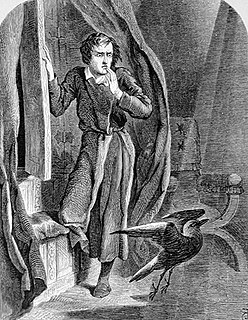
"The Raven" is a narrative poem by American writer Edgar Allan Poe. First published in January 1845, the poem is often noted for its musicality, stylized language, and supernatural atmosphere. It tells of a talking raven's mysterious visit to a distraught lover, tracing the man's slow descent into madness. The lover, often identified as a student, is lamenting the loss of his love, Lenore. Sitting on a bust of Pallas, the raven seems to further distress the protagonist with its constant repetition of the word "Nevermore". The poem makes use of folk, mythological, religious, and classical references.
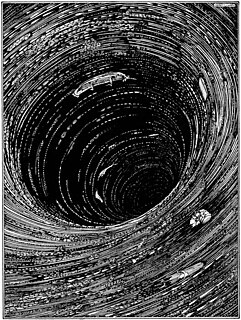
"A Descent into the Maelström" is an 1841 short story by American writer Edgar Allan Poe. In the tale, a man recounts how he survived a shipwreck and a whirlpool. It has been grouped with Poe's tales of ratiocination and also labeled an early form of science fiction.

"The Cask of Amontillado" is a short story by American writer Edgar Allan Poe, first published in the November 1846 issue of Godey's Lady's Book. The story, set in an unnamed Italian city at carnival time in an unspecified year, is about a man taking fatal revenge on a friend who, he believes, has insulted him. Like several of Poe's stories, and in keeping with the 19th-century fascination with the subject, the narrative revolves around a person being buried alive – in this case, by immurement. As in "The Black Cat" and "The Tell-Tale Heart", Poe conveys the story from the murderer's perspective.
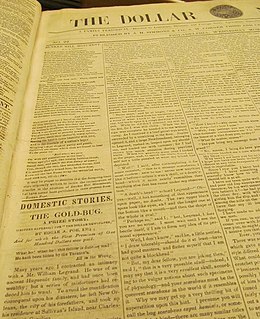
"The Gold-Bug" is a short story by American writer Edgar Allan Poe published in 1843. The plot follows William Legrand, who was bitten by a gold-colored bug. His servant Jupiter fears that Legrand is going insane and goes to Legrand's friend, an unnamed narrator, who agrees to visit his old friend. Legrand pulls the other two into an adventure after deciphering a secret message that will lead to a buried treasure.
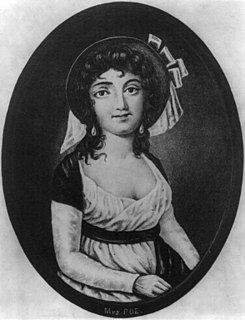
Elizabeth "Eliza" Arnold Hopkins Poe was an English actress and the mother of the American author Edgar Allan Poe.

"Al Aaraaf" is an early poem by American writer Edgar Allan Poe, first published in 1829. It tells of the afterlife in a place called Al Aaraaf, inspired by A'raf as described in the Quran. At 422 lines, it is Poe's longest poem.

"The Facts in the Case of M. Valdemar" is a short story by the American author Edgar Allan Poe about a mesmerist who puts a man in a suspended hypnotic state at the moment of death. An example of a tale of suspense and horror, it is also to a certain degree a hoax, as it was published without claiming to be fictional, and many at the time of publication (1845) took it to be a factual account. Poe toyed with the idea for a while before he admitted it to be a work of pure fiction in his marginalia.

"The Mystery of Marie Rogêt", often subtitled A Sequel to "The Murders in the Rue Morgue", is a short story by American writer Edgar Allan Poe written in 1842. This is the first murder mystery based on the details of a real crime. It first appeared in Snowden's Ladies' Companion in three installments, November and December 1842 and February 1843. Poe referred to it as one of his "tales of ratiocination".
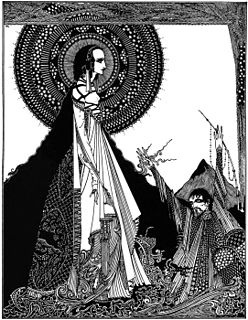
"Ligeia" is an early short story by American writer Edgar Allan Poe, first published in 1838. The story follows an unnamed narrator and his wife Ligeia, a beautiful and intelligent raven-haired woman. She falls ill, composes "The Conqueror Worm", and quotes lines attributed to Joseph Glanvill shortly before dying. After her death, the narrator marries the Lady Rowena. Rowena becomes ill and she dies as well. The distraught narrator stays with her body overnight and watches as Rowena slowly comes back from the dead – though she has transformed into Ligeia. The story may be the narrator's opium-induced hallucination and there is debate whether the story was a satire. After the story's first publication in The American Museum, it was heavily revised and reprinted throughout Poe's life.
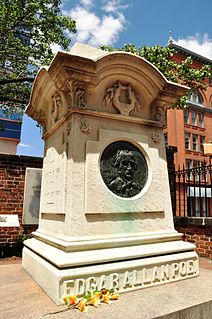
The death of Edgar Allan Poe on October 7, 1849, has remained mysterious. The circumstances leading up to it are uncertain, and the cause of death is disputed. On October 3, the American author was found delirious in Baltimore, Maryland, "in great distress, and ... in need of immediate assistance", according to the man who found him, Joseph W. Walker. He was taken to the Washington College Hospital, where he died at 5 a.m. on Sunday, October 7. He was 40 years old. Poe was never able to explain how he came to be in this condition.

Graham's Magazine was a nineteenth-century periodical based in Philadelphia established by George Rex Graham and published from 1840 to 1858. It was alternatively referred to as Graham's Lady's and Gentleman's Magazine, Graham's Magazine of Literature and Art, Graham's American Monthly Magazine of Literature and Art, and Graham's Illustrated Magazine of Literature, Romance, Art, and Fashion.

The Stylus, originally intended to be named The Penn, was a would-be periodical owned and edited by Edgar Allan Poe. It had long been a dream of Poe to establish an American journal with very high standards in order to elevate the literature of the time. Despite attempts at signing up subscribers and finding financial backers and contributors, the journal never came to be.

Politian (1835) is the only play known to have been written by Edgar Allan Poe, composed in 1835, but never completed.
"The Haunted Palace" is a poem by Edgar Allan Poe. The 48-line poem was first released in the April 1839 issue of Nathan Brooks' American Museum magazine. It was eventually incorporated into "The Fall of the House of Usher" as a song written by Roderick Usher.
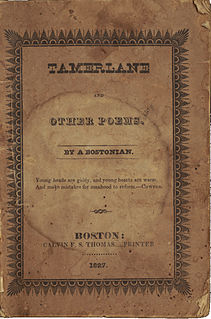
"Tamerlane" is a poem by Edgar Allan Poe that follows a fictionalized accounting of the life of a Turkic conqueror historically known as Tamerlane. The poem was first published in the 1827 collection Tamerlane and Other Poems. That collection, with only 50 copies printed, was not credited with the author's real name but by "A Bostonian". The poem's original version was 403 lines but trimmed down to 223 lines for its inclusion in Al Aaraaf, Tamerlane, and Minor Poems.
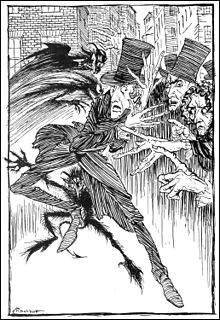
"The Imp of the Perverse" is a short story by 19th-century American author and critic Edgar Allan Poe. Beginning as an essay, it discusses the narrator's self-destructive impulses, embodied as the symbolic metaphor of The Imp of the Perverse. The narrator describes this spirit as the agent that tempts a person to do things "merely because we feel we should not."

The American Review, alternatively known as The American Review: A Whig Journal and The American Whig Review, was a New York City-based monthly periodical that published from 1844 to 1852. Published by Wiley and Putnam, it was edited by George H. Colton (1818–1847), and after his death, beginning with Volume 7, by James Davenport Whelpley. As of Volume 10, July 1849, the proprietors of the journal were Whelpley and John Priestly.

Thomas Holley Chivers was an American doctor-turned-poet from the state of Georgia. He is best known for his friendship with Edgar Allan Poe and his controversial defense of the poet after his death.

A Fable for Critics is a book-length satirical poem by American writer James Russell Lowell, first published anonymously in 1848. The poem made fun of well-known poets and critics of the time and brought notoriety to its author.

The Poets and Poetry of America was a popular anthology of American poetry collected by American literary critic and editor Rufus Wilmot Griswold. It was first published in 1842 and went into several editions throughout the 19th century.




















